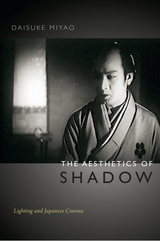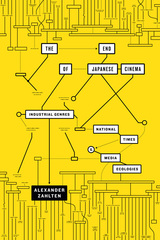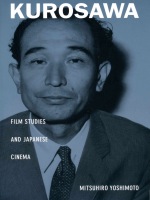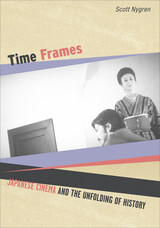4 books about Japanese Cinema

The Aesthetics of Shadow
Lighting and Japanese Cinema
Daisuke Miyao
Duke University Press, 2013
In this revealing study, Daisuke Miyao explores "the aesthetics of shadow" in Japanese cinema in the first half of the twentieth century. This term, coined by the production designer Yoshino Nobutaka, refers to the perception that shadows add depth and mystery. Miyao analyzes how this notion became naturalized as the representation of beauty in Japanese films, situating Japanese cinema within transnational film history. He examines the significant roles lighting played in distinguishing the styles of Japanese film from American and European film and the ways that lighting facilitated the formulation of a coherent new Japanese cultural tradition. Miyao discusses the influences of Hollywood and German cinema alongside Japanese Kabuki theater lighting traditions and the emergence of neon commercial lighting during this period. He argues that lighting technology in cinema had been structured by the conflicts of modernity in Japan, including capitalist transitions in the film industry, the articulation of Japanese cultural and national identity, and increased subjectivity for individuals. By focusing on the understudied element of film lighting and treating cinematographers and lighting designers as essential collaborators in moviemaking, Miyao offers a rereading of Japanese film history.
[more]

The End of Japanese Cinema
Industrial Genres, National Times, and Media Ecologies
Alexander Zahlten
Duke University Press, 2017
In The End of Japanese Cinema Alexander Zahlten moves film theory beyond the confines of film itself, attending to the emergence of new kinds of aesthetics, politics, temporalities, and understandings of film and media. He traces the evolution of a new media ecology through deep historical analyses of the Japanese film industry from the 1960s to the 2000s. Zahlten focuses on three popular industrial genres: Pink Film (independently distributed softcore pornographic films), Kadokawa (big-budget productions as part of a transmedia strategy), and V-Cinema (direct-to-video films). He examines the conditions of these films' production to demonstrate how the media industry itself becomes part of the politics of the media text and to highlight the complex negotiation between media and politics, culture, and identity in Japan. Zahlten points to a different history of film, one in which a once-powerful film industry transformed into becoming only one component within a complex media-mix ecology. In so doing, Zahlten opens new paths for uncovering similar broad processes in other large media societies.
A Study of the Weatherhead East Asian Institute, Columbia University
A Study of the Weatherhead East Asian Institute, Columbia University
[more]

Kurosawa
Film Studies and Japanese Cinema
Mitsuhiro Yoshimoto
Duke University Press, 2000
The films of Akira Kurosawa have had an immense effect on the way the Japanese have viewed themselves as a nation and on the way the West has viewed Japan. In this comprehensive and theoretically informed study of the influential director’s cinema, Mitsuhiro Yoshimoto definitively analyzes Kurosawa’s entire body of work, from 1943’s Sanshiro Sugata to 1993’s Madadayo. In scrutinizing this oeuvre, Yoshimoto shifts the ground upon which the scholarship on Japanese cinema has been built and questions its dominant interpretive frameworks and critical assumptions.
Arguing that Kurosawa’s films arouse anxiety in Japanese and Western critics because the films problematize Japan’s self-image and the West’s image of Japan, Yoshimoto challenges widely circulating clichés about the films and shows how these works constitute narrative answers to sociocultural contradictions and institutional dilemmas. While fully acknowledging the achievement of Kurosawa as a filmmaker, Yoshimoto uses the director’s work to reflect on and rethink a variety of larger issues, from Japanese film history, modern Japanese history, and cultural production to national identity and the global circulation of cultural capital. He examines how Japanese cinema has been “invented” in the discipline of film studies for specific ideological purposes and analyzes Kurosawa’s role in that process of invention. Demonstrating the richness of both this director’s work and Japanese cinema in general, Yoshimoto’s nuanced study illuminates an array of thematic and stylistic aspects of the films in addition to their social and historical contexts.
Beyond aficionados of Kurosawa and Japanese film, this book will interest those engaged with cultural studies, postcolonial studies, cultural globalization, film studies, Asian studies, and the formation of academic disciplines.
Arguing that Kurosawa’s films arouse anxiety in Japanese and Western critics because the films problematize Japan’s self-image and the West’s image of Japan, Yoshimoto challenges widely circulating clichés about the films and shows how these works constitute narrative answers to sociocultural contradictions and institutional dilemmas. While fully acknowledging the achievement of Kurosawa as a filmmaker, Yoshimoto uses the director’s work to reflect on and rethink a variety of larger issues, from Japanese film history, modern Japanese history, and cultural production to national identity and the global circulation of cultural capital. He examines how Japanese cinema has been “invented” in the discipline of film studies for specific ideological purposes and analyzes Kurosawa’s role in that process of invention. Demonstrating the richness of both this director’s work and Japanese cinema in general, Yoshimoto’s nuanced study illuminates an array of thematic and stylistic aspects of the films in addition to their social and historical contexts.
Beyond aficionados of Kurosawa and Japanese film, this book will interest those engaged with cultural studies, postcolonial studies, cultural globalization, film studies, Asian studies, and the formation of academic disciplines.
[more]

Time Frames
Japanese Cinema and the Unfolding of History
Scott Nygren
University of Minnesota Press, 2007
Until 1951, when Kurosawa’s Rashomon won the Golden Lion award for best film at the Venice Film Festival, Japanese cinema was isolated from world distribution and the international discourse on film. After this historic event, however, Japanese cinema could no longer be ignored.In Time Frames, Scott Nygren explores how Japanese film criticism and history has been written both within and beyond Japan, before and after Rashomon. He takes up the central question of which, and whose, Japan do critics and historians mean when reviewing the country’s cinema—an issue complicated by assumptions about cultural purity, Japan’s appropriation of Western ideas and technologies, and the very existence of a West and an Orientalist non-West.Deftly moving backward and forward from the pivotal 1951 festival, Nygren traces the invention of Japanese film history as a disciplinary mode of knowledge. His analysis includes such topics as the reconfiguration of prewar films in light of postwar recognition, the application of psychoanalytic theory to Japanese art and culture, and the intersection of kanji and cinema. He considers the historical inscription of 1950s Japan as “the golden age of the humanist film,” the identification of a Japanese New Wave and the implications of categorizing Japanese film through analogy to other national cinemas. Bringing the discussion to Japan’s reception of postmodernism, Nygren looks at the emergence of video art and anime and the end of Japanese film history as a meaningful concept in the rise of the Internet and globalization.Nygren highlights the creative exchange among North American, European, and Asian media, places Japanese film at the center of this discourse, and, ultimately, reveals its global role as a cultural medium, capable of transforming theory.Scott Nygren is associate professor of film and media studies at the University of Florida.
[more]
READERS
Browse our collection.
PUBLISHERS
See BiblioVault's publisher services.
STUDENT SERVICES
Files for college accessibility offices.
UChicago Accessibility Resources
home | accessibility | search | about | contact us
BiblioVault ® 2001 - 2024
The University of Chicago Press









